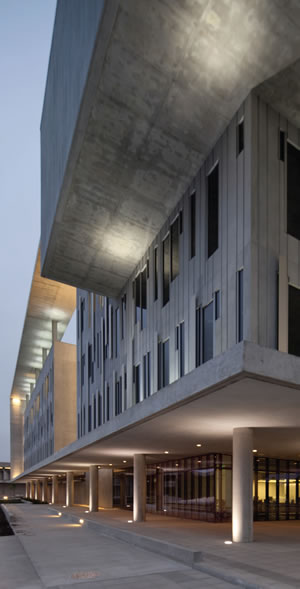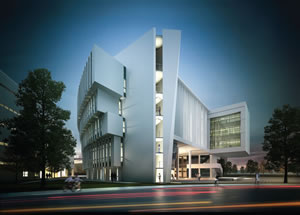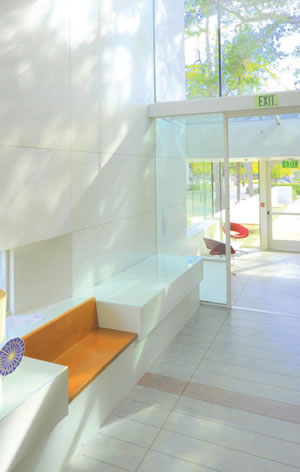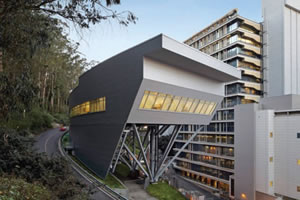Standing Strong
- By Sherrie Negrea
- 05/01/14

PHOTO © ROBIN HILL
When a tornado approached Austin Peay State University in Clarksville, TN, shortly after 4 A.M. one morning in January 1999, university officials had four minutes to alert the campus to take shelter. Because the students had practiced tornado preparedness drills, that was enough time for them to head to the lowest-level interior hallway of their residence halls to wait out the storm.
Last fall, when forecasters issued warnings that they had spotted a tornado in the Clarksville area, students at the university had a new place to take shelter: three safe rooms under three new residence halls funded by a $1.5-million grant from the Federal Emergency Management Agency. With a capacity to hold 1,400 people, the safe rooms have concrete walls that can withstand 250-mph winds and doors that automatically unlock when the campus alarm system goes off.
“It’s just a much better situation to get people below ground in a tornado rather than to be on the ground level,” says Joe Mills, assistant vice president for student affairs and director of housing.
The safe rooms are one of several recent innovative designs in campus buildings across the country that have enabled them to withstand severe weather-related events, such as tornadoes, hurricanes, earthquakes and floods. The type of design architects use depends on where the institutions are located and the type of weather conditions the region faces.
Designing for Hurricane Zones
In South Florida, buildings must be designed to meet code requirements for the state’s highest-risk hurricane zone. The state code mandates that buildings constructed in the region must be able to withstand 160-mph winds.
At Florida International University in Miami, Perkins+Will, an international architecture firm, recently designed a new academic health sciences building that can withstand hurricane damage (seen above). The building houses an atmospheric lab that must remain in operation during extreme events such as hurricanes, and a media center where reporters can broadcast news updates during a storm.

LET THE WINDS BLOW. In South Florida, including where Florida International University is located in Miami, a state code mandates that buildings constructed in the region must be able to withstand 160-mph winds.
Opened in April, the six-story building has curvilinear massing on its exterior, which better resists wind pressure, says Pat Bosch, design principal in Perkins+Will’s Miami office. Like many buildings in South Florida, the exterior was made from precast white concrete, a cost-effective and durable material for structures in a hurricane zone.
The 180,000-square-foot building also includes a curtain wall of high-impact glass, a product that came on the market in 1994, two years after Hurricane Andrew pummeled the region, causing $26 billion in damage and causing 65 fatalities. The advantage of installing walls of glass, Bosch says, is that it can allow natural daylight into the building.
“In case of a power outage, you have all this daylighting that can come in,” Bosch says. “That’s why glass is not your enemy.” Campuses that border hurricane zones must also use design elements that can make buildings resistant to extreme wind pressure. At Monmouth University in New Jersey, situated about 10 miles away from a hurricane zone, a new academic building that will be constructed this year was designed with extra structural bracing to fortify it against a hurricane. In addition, the roof on the 20,000-square-foot building used special materials that can withstand a hurricane.

SHAKE IT UP. A moment-resistant frame withstands earthquakes by a system of columns and beams that are connected to one another with fully and/or partially restrained moment connections. Loads are resisted by flexure in the beams and columns that induce shears and moments into the beams, columns and their moment-connected joints.
“You have to meet the code and take precautions so when you do have a situation — it may not be Hurricane Sandy — but when it does happen, the building has to withstand these elements,” says Obi Agudosi, senior vice president and principal of DMR Architects, which designed the building.
Strategies for Buildings in Earthquake Zones
 In Southern California, earthquakes have changed building codes so that structures are designed to withstand seismic forces. One strategy for enabling buildings to survive earthquake damage is base isolation, which elevates a building from a substructure made from high-density rubber or steel. When an earthquake occurs, the seismic forces are absorbed in the base structure, and the building can move safely without sustaining any damage.
In Southern California, earthquakes have changed building codes so that structures are designed to withstand seismic forces. One strategy for enabling buildings to survive earthquake damage is base isolation, which elevates a building from a substructure made from high-density rubber or steel. When an earthquake occurs, the seismic forces are absorbed in the base structure, and the building can move safely without sustaining any damage.
At the University of California, San Francisco, the Institute for Regenerative Medicine (seen on page 41) was built in 2010 using base isolation on a steep hillside overlooking the city. Using a solution developed by Construction Specialties, Inc., the building was designed to rest on a system of stilts, which enables it to handle horizontal and vertical movement from seismic forces. “If there’s an earthquake, this building is allowed to sit there while the foundation moves underneath it,” says Kevin Smith, engineering manager for the Expansion Joint Cover Division of Construction Specialties, in Muncy, PA.
Another technique for designing buildings to withstand earthquake damage is to use moment-resistant frames, steel structures that provide resistance to lateral forces. Michael Lehrer, founder of Lehrer Architects in Los Angeles, used this technique in designing a building for the Keck Institute for Space Studies at California Institute of Technology in Pasadena (seen on pages 38 and 40).
Cross bracing was also installed around windows and glass doors, so that natural light could be brought into the 20,000-square-foot building. Because of its size, Lehrer says base isolation was not needed.
“This is all about design and maximizing value,” he says. “What is the optimal solution and what are you protecting? For a smaller building the size of the Cal Tech project, the loads are not so massive.”

PHOTO COURTESY OF CONSTRUCTION SPECIALTIES, INC.
ISOLATED STRENGTH. For resistance to seismic events, base isolation works by separating (“isolating”) a structure from the earth, and therefore the lateral forces of an earthquake. There are two types of base isolation — elastomeric and sliding — designed to take the weight of the building and let the foundations move sideways during an earthquake.
Solutions to Deter Flooding
Ohio State University in Columbus confronted another weather-related problem — flooding — when it developed a new master plan for the area of campus near the Wexner Medical Center. Because the medical center was adjacent to the Olentangy River, its parking lot was in a flood plain, which left no land available for the center’s planned expansion.
Sasaki Associates, a planning, design and architecture firm based in Watertown, MA, proposed moving the road that ran alongside the river and elevating it so that it could act as a levy to protect the medical center from flooding. In addition, the firm recommended removing a dam along the river, which lowered the water level by two feet.
These strategies generated 12 acres of developable land that the medical center is now using for an expansion project.
“It was really a win-win situation on a number of levels,” says Tyler Patrick, principal planner for Sasaki. “It improved the quality of the river corridor, created more recreational and research land for the campus, and prevented the flooding of the medical center.”
This article originally appeared in the issue of .